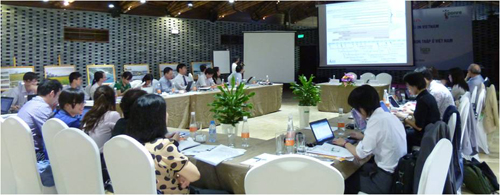ベトナム会合:ベトナムの低炭素社会
 ■ Date: 25 April 2013
■ Date: 25 April 2013
■ Venue: Vinh Phuc, Viet Nam
■ Organiser:
Institute of Strategy and Policy on Natural Resources and Environment (ISPONRE), Viet Nam
National Institute for Environmental Studies (NIES), Japan
Kyoto University, Japan
Institute for Global Environmental Strategies (IGES)/ Low Carbon Asia Research Network (LoCARNet), Japan
Mizuho Information and Research institute, Japan
Summary of the workshop
Vietnam workshop “Low Carbon Society (LCS) in Vietnam” was held on 25th April 2013, Vinh Phuc, Viet Nam. It was organised by ISPONRE, Kyoto University (KU), National Institute for Environmental Studies (NIES) and Institute for Global Environmental Strategies (IGES)/LoCARNet (Low Carbon Asia Research Network).
The workshop aimed to develop low carbon strategy and NAMA to reduce emissions with promotion of new mechanism, technology transfer and financial support in Vietnam. The mitigation potential is energy, waste, land use and land use change. This workshop is expected to develop forecast and estimation of GHG emissions and reduction potentials in forest and land use and waste sector in Vietnam.
What is AIM model?
Asian Integrated Model (AIM) is a simulation model of comprehensive activities for low carbon development to be consistence to climate change strategies. In the begging of session, low carbon policy making process and the application of the AIM model was introduced.
Study on Low Carbon Scenario in Vietnam
After the introduction of AIM model, the report on National Low Carbon towards 2030 in Vietnam was presented. The report aims to discuss the possibility of developing a low carbon society in Vietnam. The low carbon scenario consists of future changes in demography, transport, industry, agriculture, forestry, land use, energy demand and greenhouse gas (GHG) emissions.
Integrated Assessment Model in agriculture, forestry and land use sector
The details of the model used in the report were also presented in the presentation “AFOLU and WASTE model structure and data requirements” by Kyoto University. There are two type of agriculture and forestry and land use and land use change model, AFOLUA and AFOLUB model. AFOLUA model is Agriculture, Forestry and Other Land-use Activity Model while AFOLUB model is Agriculture, Forestry and Other Land-use Bottom-up model. AFOLUA calculates future activity level of agriculture, forestry and other land use sectors, and GHG emissions from these sectors can be projected in looking at the consistency in macro economics. AFOLUA model can identify detailed mitigation potential of each low carbon countermeasures. On the other hand, AFOLUB model can calculate the optimisation and cost-effectiveness because cost of counter measures is explicitly considered with the estimation that is based on the detailed information of specific technologies. Using the AFOLUB model, GHG emissions is estimated based on economically reasonable choice of options, and the effect of policies such as carbon tax, energy tax, subsidy etc can be analysed.
Discussion
Active discussion was held between participants in Vietnam and AIM team regarding the AFOLU and Waste model. Through the discussion, it was expected for the participants to clarify the model structure and to make sure how to apply the model in Vietnam. A participant pointed out a concern about inventory system and the data reliability in Vietnam. Also a question was raised on how to deal with the uncertainty of technology and market development in Vietnam in the model. As the response to the questions and concerns, AIM team emphasised it is important to clarify what we want to do using the model. AIM model is used to intensify the discussion among policymakers and stakholders, and to find out more effective and reliable policy options.

